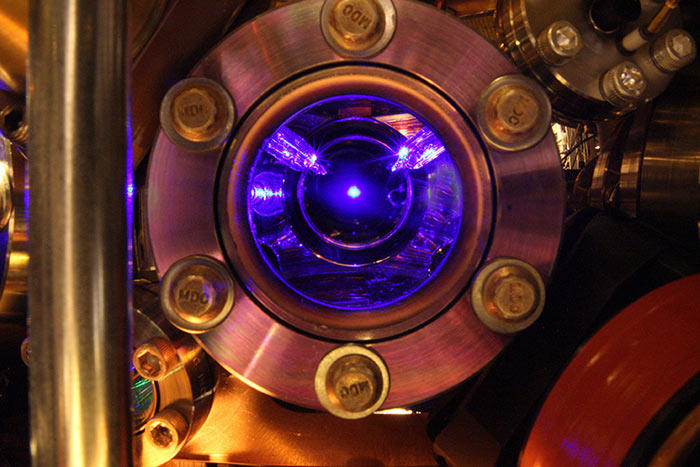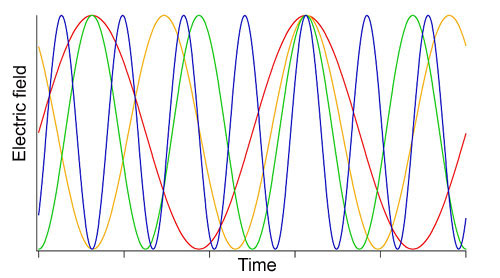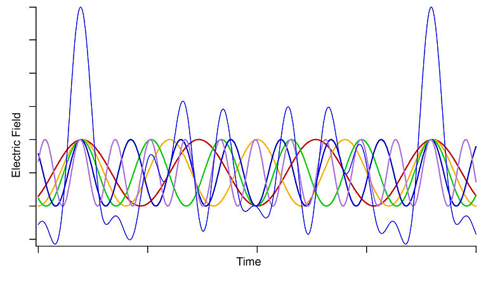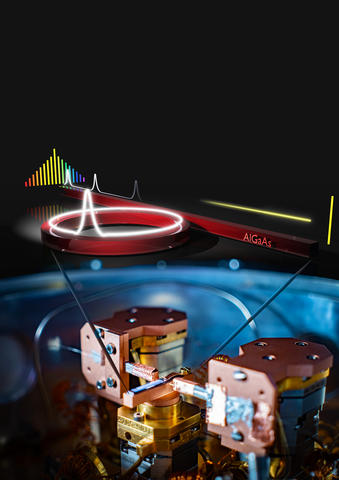Optical Frequency Combs
What do optical frequency combs do?
Optical frequency combs are specialized lasers that act like a ruler for light. They measure exact frequencies of light — from the invisible infrared and ultraviolet to visible red, yellow, green and blue light — quickly and accurately.
These Nobel Prize-winning devices fill an important technological gap. Optical frequency combs allow scientists to measure and control light waves as if they were radio waves. With optical frequency combs, technologies that employ radio and microwave frequencies — such as clocks, computers and communications — are now seamlessly connected to optical waves that oscillate at 10,000 times higher frequencies.
Optical frequency combs began as part of NIST scientists’ vision for better optical atomic clocks in the late 1990s. Today, NIST scientists are at the forefront of advancing these tools, and they have found uses beyond just timekeeping.
How are optical frequency combs used?
Timekeeping
Optical frequency combs have been revolutionary for atomic clocks and timekeeping. Optical atomic clocks mark the passage of time by counting the natural oscillation of atoms in the same way a grandfather clock counts the swings of a pendulum. These atoms oscillate about 500,000 billion times a second — a much higher frequency than standard microwave-based atomic clocks. The current electronic systems that are used to measure frequency for microwave-based atomic clocks simply can’t count the optical “ticks.”
Because the teeth of an optical frequency comb are evenly spaced and precise, the comb acts like the gears of a clock, taking the faster optical frequencies and dividing them down to the lower-frequency microwave signals used by electronics and current atomic clocks. This lets scientists link optical atomic clocks’ higher-frequency “ticks” to microwave-based clocks’ lower-frequency “ticks” and electronics used by present day computers and communications systems.
With these “gears” carrying accurate signals between electronics, microwave-based tools and optical atomic clocks, scientists can use these powerful new clocks for faster, more accurate timekeeping systems. Optical atomic clocks may eventually redefine the second.
In order for these new clocks to be used for national and global timekeeping, scientists need to be able to compare signals from clocks across distances. Optical frequency combs can help achieve that too. NIST and JILA, a joint research institute of NIST and CU Boulder, used lidar to send time signals through the air, comparing two different kinds of atomic clocks.
Improved timekeeping systems are crucial in many technological applications, from stock trading to navigation. Global Positioning System (GPS) satellites and receivers send radio signals back and forth and use the timing of those signals to pinpoint a user’s location. GPS uses military time, and those clocks check their timing periodically with civilian clocks, like NIST’s optical atomic clocks and others like them around the world. Scientists hope to have optical atomic clocks on navigation satellites in the future, making the system even more precise and allowing GPS to pinpoint locations within centimeters.
Optical atomic clocks are also useful in the pursuit of quantum physics. By dividing time into incredibly small slices, scientists can use these clocks to measure previously undetectable changes, such as the gravitational red shift over short distance scales, the effect of gravity on the passage of time.

Astronomy and cosmology
Advanced optical atomic clocks also allow scientists to study the constants of nature beyond our own planet. For example, with the help of optical frequency combs, NIST scientists are using these improved clocks to search for elusive dark matter.
Optical frequency combs also are helping scientists search for exoplanets around distant stars. By tracking the exact colors of light from these stars, they can look for a wobble in the motion of a star that would indicate the presence of an Earth-like planet orbiting the star.
Precise distance measurement
Optical frequency combs work over long distances. In 2013, NIST patented lidar, a light detecting and ranging system that utilizes optical frequency combs to measure the distance to an object by analyzing light reflected from it.
This is already being used in a few research applications. NIST’s fire research laboratory has used frequency combs to “see” through flames and identify melting objects. Frequency comb-based lidar has also been used to create 3D maps. Eventually, lidar using optical frequency combs could keep satellites and other space instruments flying in tight formations, acting as a single instrument.
Atmospheric science and greenhouse gases
Atoms and molecules can be identified by which frequencies of light they absorb. Since optical frequency combs generate millions of frequencies in short pulses, they can be used to quickly and efficiently study the quantity, structure and dynamics of various molecules and atoms.
This has many potential applications and is already being used to study pollution. Using optical frequency combs, scientists at JILA have studied short-lived molecules that link burning fossil fuels to air pollution. The structure and dynamics of large and complex molecules can also be probed by frequency combs.
Scientists are also working on using optical frequency combs to detect trace amounts of various molecules in gases. In 2019, scientists and engineers from NIST, University of Colorado Boulder, and LongPath Technologies developed a dual-comb, portable spectroscopy system to detect minute methane emissions from oil and gas fields.

Medical diagnostics
The optical frequency comb may have applications in medicine as well. Just as it can be used in chemistry applications, the comb could be used to detect trace molecular indicators of disease. Scientists at JILA have been experimenting with combs to create breathalyzers that detect disease.
How do optical frequency combs work?
Frequency combs measure an unknown optical frequency by measuring the repetition rate of a continuous train of light pulses — which lies in the larger, easy-to-measure radio frequency range.
Light encompasses a broad spectrum of colors, which travel in waves. Each of those colors of light — from the invisible infrared and ultraviolet to red, blue or yellow visible light — has a corresponding frequency, or the number of wave peaks that pass a fixed point every second.
Radio waves and microwaves also travel at the speed of light, but their peaks are much farther apart, allowing modern electronics to count and track them easily.

Optical frequency combs emit a continuous train of very brief, closely spaced pulses of light containing a million different colors, spanning from the invisible infrared through the visible and into the ultraviolet spectrum.
Thanks to a technique called “mode locking,” all of the frequencies in each pulse start in phase, in sync with each other.
The result resembles the teeth of a comb, separating each frequency into a distinct spike — hence the name of the device. The spacing of those teeth is very fine and exactly even, and they act like ticks on a ruler to measure light emitted by stars, atoms, other lasers, etc. with extreme precision and accuracy.

How were optical frequency combs created?
While they may sound simple, optical frequency combs are the result of decades of research and innovation, including significant contributions from NIST.
Physicists had been toying with the idea of this specialized laser since the 1970s, when Theodor Hänsch of the Max Planck Institute for Quantum Optics in Germany proposed a model for the first optical frequency comb while he was at Stanford University. Scientists knew that continuous lasers could only produce one color of light, but pulsed lasers could generate multiple colors. The shorter the pulse, the more frequencies the laser could produce.
Scientists needed to know the spacing between the “teeth” — the individual frequencies of light — of the comb. This required mode locking lasers. Mode locking forces all the colors in each pulse to start out in phase with each other.
In the mid-1990s, lasers made with titanium-doped sapphire crystals could produce these synchronized frequencies in femtoseconds — millionth of a billionth of a second pulses.

Scientists also needed to calibrate the comb, to adjust it to a known frequency. Calibrating the comb would determine the offset frequency, or where the “ticks” on the comb start in an absolute sense. Hänsch realized that the best way to do that was to get the comb to produce an octave of frequencies, where the highest frequency was at least double the lowest frequency. Interfering a frequency with its double — called “self-referencing” — let scientists determine each frequency exactly.
That wasn’t possible until a team of scientists at Bell Laboratories created a hair-thin optical fiber that could deliver more than an octave range of frequencies. This was a crucial development for optical frequency combs, and the final piece of the puzzle. With this optical fiber, Jan Hall and his colleagues at JILA could develop the self-referencing technique they needed in 1999. They were the first to compare the operation of multiple femtosecond frequency combs, thereby demonstrating reproducibility.
Hall and his team of physicists at JILA, including Steven Cundiff, Scott Diddams, David Jones and Jun Ye, developed several other techniques that pushed the optical frequency comb closer to reality. In the late 1990s, the team developed a calibration system for the femtosecond laser, creating controllable, well-defined pulses containing thousands of colors. They had also improved stabilization for the laser, making it steady. In 2005, Hall and Hänsch shared part of the Nobel Prize in Physics for their contributions to the optical frequency comb.
What’s next for optical frequency combs?
Since 1999, NIST and JILA scientists have rapidly advanced the comb, and are still at the forefront of optical frequency comb advancement and innovation. Today’s optical frequency combs span a greater range of electromagnetic frequencies than their earlier counterparts, from the deep infrared into the extreme ultraviolet. The ultraviolet comb can one day be used to drive transitions in the nucleus of atoms, which would unlock new possibilities for clocks and spectroscopy to study the nano world.

Fiber laser frequency combs were the next significant advance in optical frequency combs. NIST and JILA scientists contributed significantly to creating and refining these combs. Using common fiber components from telecommunications, these combs can operate continuously and are more compact than the original optical frequency comb. This makes them “workhorses” for metrology. They are currently used for numerous experiments (including clocks) in NIST and other laboratories, and in field applications like lidar and the aerospace industry. Fiber laser frequency combs are also being considered and tested to go into space. NIST scientists and engineers are continually improving fiber laser combs’ performance, power and durability to use in new applications and environments.
While many frequency combs currently are about the size of a shoebox and are widely available for use in and outside of laboratories, scientists have been working diligently to shrink them. Scientists have been working to produce optical frequency combs so small they can fit on a microchip.
Many scientists hope that if frequency combs can fit on a microchip, they can have even greater commercial applications. Microcombs have the potential to improve communications systems, particularly within data centers and other high performance computing systems. The spectroscopy power of optical frequency comb could be incorporated into smartphones and wearable technology to monitor health.
Those applications are far in the future, however. Currently microcombs require tools outside of the chip to operate, such as power supplies, amplifiers and pump lasers. Many of these parts have been miniaturized, but integrating them all onto a single chip is very challenging. But perhaps the greatest hurdle to overcome is making these microcombs self-referencing, which is necessary to make the combs accurate.
Research is making progress to overcome those hurdles. Even if a complete comb-on-a-chip is never realized, microcombs are already finding uses in research. With miniature dual frequency combs, NIST has already developed a chip-scale atomic clock. Scientists at NIST and their collaborators will continue to explore the vast potential for microcombs, fiber laser frequency combs and optical frequency combs.





